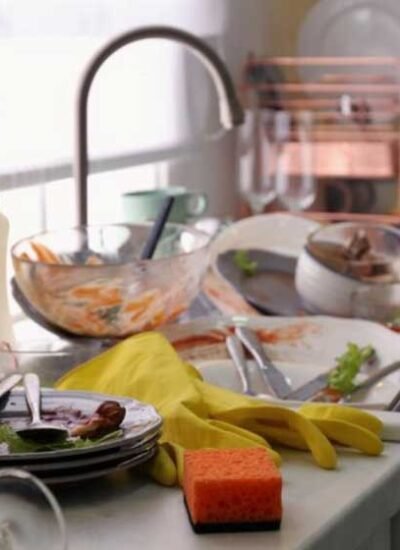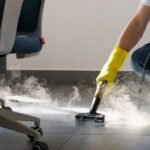Your kitchen is one of the hardest-working areas in your home, and over time, that daily wear and tear starts to show. But what if some of the biggest culprits behind your kitchen’s aging were everyday habits? The good news is that a little awareness—and a few smart fixes—can help reverse the damage and keep your kitchen looking fresh for years to come, notes Sun-Pro Realty and Management Services.
Here are some kitchen habits that could be making your home age faster—and what to do about them.
1. Forgetting to Maintain the Garbage Disposal
The Problem: Your garbage disposal is an unsung hero in the kitchen—until it starts acting up. Letting food waste, grease, or hard items like bones go down the drain can lead to clogs, odors, and even motor failure. A neglected disposal system can also cause plumbing issues, which may lead to expensive repairs down the road.
How to Fix It:
- Avoid putting fibrous foods, grease, and coffee grounds down the disposal.
- Run cold water before, during, and after using the disposal to flush food particles through.
- Clean it regularly by grinding ice cubes and citrus peels to keep blades sharp and odors at bay.
- When your disposal is making strange noises, draining slowly, or producing bad smells despite cleaning, it may need professional repair or replacement.
If you suspect your system needs a tune-up, get tips and solutions from Travis County Appliance Repair for a well-maintained garbage disposal.
2. Ignoring Water Damage Around the Sink
The Problem: Water splashes from dishwashing, leaky faucets, and damp sponges might seem harmless, but they can lead to warped wood, stained cabinets, and even mold growth over time. Water damage is one of the biggest contributors to an old-looking kitchen.
How to Fix It:
- Wipe up water spills immediately—especially around the edges of the sink.
- Check under the sink regularly for leaks and moisture buildup.
- Install a splash guard or use an absorbent mat near the sink to prevent water from seeping into cabinets.
- If you already see signs of damage, consider resealing or refinishing the affected areas before the problem worsens.
3. Letting Grease Build Up on Cabinets and Walls
The Problem: Cooking produces invisible grease particles that settle on kitchen surfaces. Over time, they create a sticky film that attracts dust and dirt, making cabinets look dull and yellowed.
How to Fix It:
- Wipe down cabinets and walls weekly with a gentle degreaser or a vinegar-and-water solution.
- Use range hood vents when cooking to trap grease before it settles on surfaces.
- For stubborn buildup, a mixture of baking soda and warm water can help break down sticky grease.
4. Using Harsh Cleaners on Countertops
The Problem: Some cleaning products can be too aggressive for kitchen surfaces, especially natural stone, laminate, and wood. They can strip away protective coatings, causing discoloration and premature wear.
How to Fix It:
- Avoid using bleach, ammonia, or abrasive cleaners on delicate surfaces.
- Stick to mild dish soap, water, and pH-balanced cleaners designed for your countertop material.
- If countertops are already showing damage, consider resealing them (for stone surfaces) or applying a protective oil treatment (for wood).
5. Overloading Cabinets and Drawers
The Problem: We’ve all been guilty of stuffing cabinets to the brim. But too much weight can cause shelves to warp, hinges to loosen, and drawers to stick—making your kitchen look and feel worn out.
How to Fix It:
- Declutter your kitchen storage at least once a year. Donate or discard items you don’t use.
- Use shelf liners and dividers to organize items without overloading one area.
- If cabinet doors are sagging or drawers are misaligned, tighten hardware or install soft-close hinges to prolong their life.
6. Using the Wrong Cutting Board (or Skipping It Altogether!)
The Problem: Chopping directly on countertops can leave deep scratches, especially on laminate and wood surfaces. These scratches become a breeding ground for bacteria and make countertops look damaged and worn.
How to Fix It:
- Always use a cutting board to protect your counters.
- Choose a material that’s gentle on knives but durable enough for everyday use, like wood or plastic.
- If countertops are already scratched, consider sanding and resealing them or using a decorative cutting board to cover the damage.
7. Not Replacing Old Caulk and Grout
The Problem: Caulk around sinks and grout between tiles can become stained, cracked, or moldy, making the kitchen look older than it really is.
How to Fix It:
- Inspect caulk and grout every six months for signs of wear.
- Remove and replace old and discolored caulk with a fresh bead to prevent moisture damage.
- Scrub grout lines with a baking soda and hydrogen peroxide paste to remove stains and restore brightness.
8. Letting Natural Light Fade Surfaces
The Problem: While natural light brightens up a kitchen, prolonged exposure to direct sunlight can fade wood floors, cabinets, and even countertops over time.
Click here for tips on great window options.
How to Fix It:
- Install UV-blocking window films or sheer curtains to filter harsh sunlight.
- Rotate rugs and furniture occasionally to prevent uneven fading.
- If fading has already occurred, refinishing or repainting cabinets and floors can help restore their appearance.
9. Skipping Regular Appliance Maintenance
The Problem: A kitchen’s efficiency depends on its appliances, yet many homeowners forget to clean or maintain them until something goes wrong. A poorly maintained oven, fridge, or dishwasher not only shortens the appliance’s lifespan but also affects the overall functionality of your kitchen.
How to Fix It:
- Clean refrigerator coils every six months to improve energy efficiency.
- Run an empty cycle with vinegar in your dishwasher monthly to remove buildup.
- Check oven seals and replace them if heat is escaping.
- For appliances that are slow, noisy, or underperforming, professional maintenance can help avoid costly replacements.
Keep Your Kitchen Young
Your kitchen doesn’t have to age before its time. By breaking these common habits and making small changes, you can extend the life of your kitchen and keep it looking—and functioning—like new. Regular maintenance, smart cleaning choices, and a little TLC go a long way in preserving one of the most important spaces in your home.





Leave a Reply